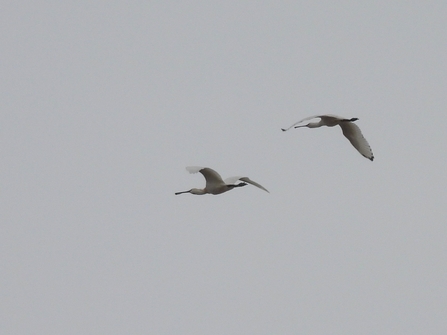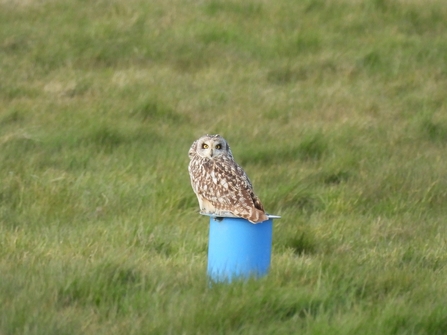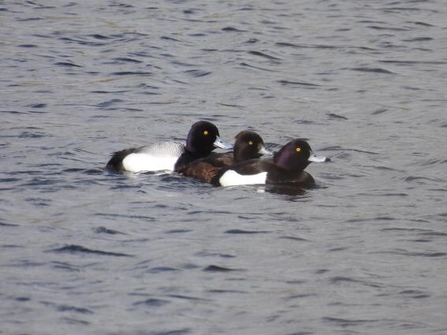Red kites were again a regular sight early in the month with four birds noted, including 3 together on 4th April. A first-summer Iceland gull was also recorded flying north on this date and was presumed to be the same bird seen in March. Two spoonbill flew south on 24th.
Lincolnshire Coastal Country Park – April 2021

Spoonbills – note the black wing tips of the immature bird © Garry Wright
The northerly winds created some good sea watching conditions during the month. 326 kittiwake and a Manx shearwater were noted off Huttoft Car Terrace on 6th. Three fulmar, numerous gannets, two red-throated diver, two Manx shearwater and two eider from Huttoft Car Terrace on 28th.
Cold weather during the month delayed the departure of some winter migrants with goldeneye on Chapel Pit on 2nd and snow bunting on 7th and multiple brambling records throughout the month.
Other signs of delayed migrants are the big flocks of wood pigeon on the coast which usually depart back to Scandinavia in March/early April (still present in early May). However, the whooper swan herd departed in the first week of April.
The majority of spring migrants arrived during the month with some arriving later than expected presumably delayed by the weather. Typically, warm southerly air flows are desirable during spring for the arrival of the summer migrants. The only migrants yet to arrive are the sandpipers, terns and swift. It is interesting to compare the arrival dates of some species, such as greenshank and sedge warbler that have returned on the exact same day as last year.
Anderby Marsh continued to support a pair of redshank until the end of the month when the marsh had dried up due to the extreme drought conditions. Other highlights from this location in April include a near resident black-tailed godwit, numerous whimbrel, one-three little ringed plover present over 10 dates (a potential breeding candidate in future years) and green sandpiper. A pair of avocet also flew south over here on 13th this is still a scarce species in the area.
The National Trust’s Sandilands Golf Course continues to support short-eared owls (up to three birds) with one bird observed caching food towards the end of the month.

Short-eared owl © Garry Wright
A survey of the southern section in late April revealed at least six pairs of skylark and 12 pairs of meadows pipit. Whimbrel and yellow wagtail were also regularly recorded feeding on the short turf. A pair of stonechat were also observed on the 19th and a showy male ring ouzel on several dates.
A third pair of marsh harrier have taken up residence in the area and showing strong signs of breeding behaviour. In addition to this, a Common Bird Census survey carried out in late April between Chapel Six Marshes and Anderby Creek revealed a spectacular number of birds with 55 sedge warbler, 15 whitethroat, nine Cetti’s warbler, 52 linnet and 26 reed bunting. The breeding density of sedge warbler in particularly must be one of the highest in the county or even country; the estimated total for the Country Park as a whole probably in excess of 100 breeding pairs.
Birds of conservation concern were also well represented with good numbers of both linnet and reed bunting throughout. Linnet is a red-listed species (75% decline over 25 years) and reed bunting is an amber listed species (50% decline over 25 years).

Lesser scaup © Garry Wright
Some excitement ensued on 29th with the finding of a lesser scaup on Chapel Pit. This is a rare visitor from North America and very similar in appearance to the slightly more familiar greater scaup. It was the sixth record for Lincolnshire, a first for the Coastal Country Park area and the first to be recorded in the UK in 2021! On average there are about 5-10 records annually in the UK.
Non-avian highlights
At least eight smooth newts were consumed by a grey heron in 10 minutes on Huttoft Marsh on the afternoon of 16th April.
Brown hares were regularly observed on Anderby Marsh and Huttoft Marsh throughout the month. Roe deer numbers continue to increase on neighbouring farmland with counts of in excess of 30 animals some days.
A single green hairstreak butterfly was noted by the Anderby tower hide mid-month during a brief warm spell.
An emergence of St Mark’s flies was evident in the latter days of the month; look out for their distinctive dangling legs in flight.
It was overall a very poor month for insects with prolonged sub-zero temperatures.
Top five species to look for in May
- Sandwich tern - can be seen over the sea at any location; listen out for their scratchy calls from the beach.
- Grasshopper warbler - listen for their unique song likened to a ‘fishing reel’, several pairs breed in the area, best looked for between Wolla Bank car park and Anderby Creek.
- Broad-bodied chaser dragonfly - look out for this early emerging species at Chapel Nature Area and Chapel Six Marshes).
- Green hairstreak butterfly - found between Wolla Bank and the Anderby Tower hide on warm days; checking any sunlit hawthorns and elder trees in particular.
- Marsh harrier - this impressive bird of prey can be found throughout the Lincolnshire Coastal Country Park.
Grasshopper warbler - generally a shy species that's not often seen. This one was glanced briefly at Wolla Bank © Garry Wright

